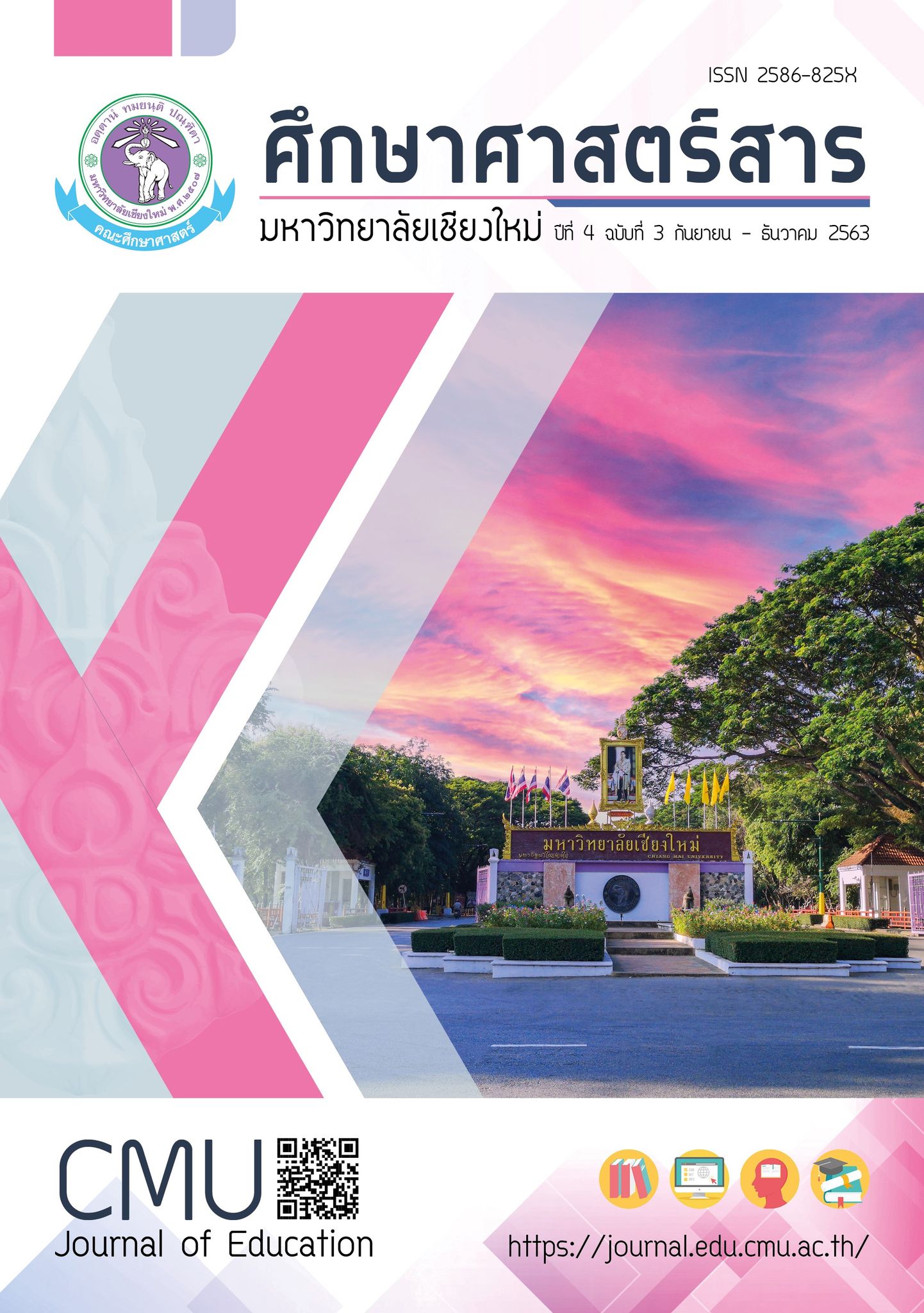ธรรมชาติของคณิตศาสตร์ผ่านมุมมองจากทฤษฎีสรรคนิยมทางสังคม
Main Article Content
บทคัดย่อ
บทความนี้มุ่งบ่งชี้ลักษณะของธรรมชาติของคณิตศาสตร์ผ่านมุมมองจากทฤษฎีสรรคนิยมทางสังคม ซึ่งอธิบายว่า ความรู้เป็นสิ่งที่มนุษย์สร้างขึ้น ผ่านประสบการณ์กับสิ่งแวดล้อมทางกายภาพ และปฏิสัมพันธ์ภายใต้บริบททางสังคมและวัฒนธรรม แต่กระนั้นก็ตาม ความรู้ทางคณิตศาสตร์มักถูกมองว่าเป็นสิ่งที่มีอยู่แล้ว แน่นอน เป็นสากล และเป็นอิสระจากมนุษย์ ดังนั้น การบ่งชี้ลักษณะพื้นฐานของธรรมชาติของคณิตศาสตร์บนพื้นฐานของทฤษฎีสรรคนิยมทางสังคมจึงอาจให้แนวทางในการจัดการเรียนการสอนคณิตศาสตร์ที่สอดคล้องกับญาณวิทยาของการเรียนรู้ของมนุษย์มากขึ้น โดยคณิตศาสตร์มีธรรมชาติที่มีลักษณะเชิงประจักษ์ ลักษณะเชิงอนุมาน ลักษณะเชิงอัตวิสัย ลักษณะที่ไม่จีรัง ลักษณะเชิงสร้างสรรค์ และลักษณะทางสังคมและวัฒนธรรม เฉกเช่นเดียวกับธรรมชาติของวิทยาศาสตร์
Article Details

อนุญาตภายใต้เงื่อนไข Creative Commons Attribution-NonCommercial-NoDerivatives 4.0 International License.
หากผู้เสนอบทความมีความจำเป็นเร่งด่วนในการตีพิมพ์โปรดส่งลงตีพิมพ์ในวารสารฉบับอื่นแทน โดยกองบรรณาธิการจะไม่รับบทความหากผู้เสนอบทความไม่ปฏิบัติตามเงื่อนไขและขั้นตอนที่กำหนดอย่างเคร่งครัด ข้อมูลของเนื้อหาในบทความถือเป็นลิขสิทธิ์ของ Journal of Inclusive and Innovative Education คณะศึกษาศาสตร์ มหาวิทยาลัยเชียงใหม่
เอกสารอ้างอิง
ทิพย์รัตน์ นพฤทธิ์ และ เจนสมุทร แสงพันธ์. (2557). ธรรมชาติของความรู้ทางคณิตศาสตร์สำหรับการสอนของนักศึกษาครูในโรงเรียนที่ใช้นวัตกรรมการศึกษาชั้นเรียนและวิธีการแบบเปิด. วิทยาสารเกษตรศาสตร์ (สังคมศาสตร์), 35(2), 245-256.
ลือชา ลดาชาติ. (2561). การเรียนการสอนวิทยาศาสตร์ที่เป็นวิทยาศาสตร์: ประวัติศาสตร์ ปรัชญา และการศึกษา. กรุงเทพฯ: สำนักพิมพ์แห่งจุฬาลงกรณ์มหาวิทยาลัย.
ลือชา ลดาชาติ และ ลฎาภา ลดาชาติ. (2560ก). การสร้างแผนภาพความเข้าใจธรรมชาติของวิทยาศาสตร์ของผู้เรียน. ศึกษาศาสตร์สาร มหาวิทยาลัยเชียงใหม่, 1(1), 6-16.
ลือชา ลดาชาติ และ ลฎาภา ลดาชาติ. (2560ข). ทฤษฎีความผันแปร: อีกมุมมองเกี่ยวกับการเรียนรู้. ศึกษาศาสตร์สาร มหาวิทยาลัยเชียงใหม่, 1(2), 37-51.
ลือชา ลดาชาติ, ลฎาภา สุทธกูล, และ ชาตรี ฝ่ายคำตา. (2556). ความแตกต่างที่สำคัญระหว่างการส่งเสริมการเรียนการสอน “ธรรมชาติของวิทยาศาสตร์” ภายนอกและภายในประเทศไทย. วิทยาสารเกษตรศาสตร์ (สังคมศาสตร์), 34(2), 269-282.
สำนักงานคณะกรรมการการศึกษาแห่งชาติ. (2545). พระราชบัญญัติการศึกษาแห่งชาติ พ.ศ. 2542 (แก้ไขเพิ่มเติม พ.ศ. 2545). กรุงเทพฯ: บริษัทพริกหวานกราฟฟิก จำกัด.
Abd-El-Khalick, F., Bell, R. L., & Lederman, N. G. (1998). The nature of science and instructional practice: Making the unnatural natural. Science Education, 82(4), 417-436.
Akerson, V. L., Abd-El-Khalick, F., & Lederman, N. G. (2000). Influence of a reflective explicit activity-based approach on elementary teachers’ conceptions of nature of science. Journal of Research in Science Teaching, 37(4), 295-317.
Akerson, V. L. & Volrich, M. (2006). Teaching nature of science explicitly in a first-grade internship setting. Journal of Research in Science Teaching, 43(4), 377-394.
American Association for the Advancement of Science. (1990). The nature of mathematics. Retrieved from http://www.project2061.org/publications/sfaa/online/chap2.htm
Christiansen, B. (1969). Induction and deduction in the learning of mathematics and in mathematical education. Educational Studies in Mathematics, 2(2/3), 139-159.
Dewey, L. (1910). How we think. New York: DC: Heath & Co Publishers.
Dossey, J. A. (1992). The nature of mathematics: Its role and its influence. In D. A. Grouws (Ed.), Handbook of Research on Mathematics Teaching and Learning (pp. 39-48). New York: MacMillan.
Edwards, L. D. (2003, February). The nature of mathematics as viewed from cognitive science. In M. A. Mariotti (Ed.), Paper presented at the 3rd congress of the European society of research in mathematics. Organized by European Society for Research in Mathematics Education, Bellaria, Italy.
Ernest, P. (1992). The Nature of mathematics: Towards a social constructivist account. Science and Education, 1(1), 89-100.
Ernest, P. (1993a). Are there revolutions in mathematics. Humanistic Mathematics Network Journal, 8(21), 63-65.
Ernest, P. (1993b). Constructivism, the psychology of learning, and the nature of mathematics: Some critical issues. Science and Education, 2(1), 87-93.
Ernest, P. (1996). The nature of mathematics and teaching. Retrieved from http://www.academia.edu/download/31378390/THE_NATURE_OF_MATHEMATICS_AND_TEACHING.doc.
Gonzalez-Valasco, E. A. (2010). Journey through mathematics: Creative episodes in its history. New York: Springer.
Kean, L. (2017). Using beliefs about the nature of mathematical knowledge in teaching college algebra. In B. Gold, C. E. Behrens, & R. A. Simons. (Eds.), Using the philosophy of mathematics in teaching undergraduate mathematics (pp. 63-72). Washington, DC.
Kuhn, T. S. (1970). The structure of scientific revolution. Chicago: The University of Chicago Press.
Lakoff, G. & Nunez, R. E. (2000). Where mathematics comes from: How the embodied mind brings mathematics into being. New York: Basics Books.
Lerman, S. (1990). Alternative perspectives of the nature of mathematics and their influence on the teaching of mathematics. British Educational Research Journal, 16(1), 53-61.
Major, W. E. & Laughy, M. (n.d.). Ancient Greek for everyone: Adverbs and numbers. Retrieved from https://ancientgreek.pressbooks.com/chapter/33/
Marton, F. (2015). Necessary conditions of learning. New York: Routledge Falmer.
Nikolantonakis, K. (2007, July). Did we have “revolutions” in mathematics? Examples from the history of mathematics in the light of T. S. Kuhn’s historical philosophy of science. In E. Barbin, N. Stehlikova, & C. Tzanakis (Eds.), Proceedings of the 5th European summer university. Organized by Mathematical Association of America, Prague, Czech Republic.
Nunez, R. F. (2000, July). Mathematical idea analysis: What embodied cognitive science can say about the human nature of mathematics. In T. Nakahara, & M. Koyama (Eds.), Paper presented at the 24th conference of the international group for the psychology of mathematics education. Organized by International Group for the Psychology of Mathematics Education, Hiroshima, Japan.
Pair, J. D. (2018, February). The creation of a humanistic educational framework for the nature of pure mathematics. In A. Weinberg, C. Rasmussen, J. Rabin, M. Wawro, & S. Brown (Eds.), Proceedings of at the 21st annual conference on research on undergraduate mathematics education. Organized by the Special Interest Group of the Mathematical Association of America (SIGMAA) for Research in Undergraduate Mathematics Education, San Diego, CA.
Schwartz, R. S. & Lederman, N. G. (2002). “Its’ the nature of the beast”: The influence of knowledge and intentions on learning and teaching nature of science. Journal of Research in Science Teaching, 39(3), 205-236.
Schwartz, R. & Lederman, N. (2008). What scientists say: Scientists’ views of nature of science and relation to science context. International Journal of Science Education, 30(6), 727-771.
Schwartz, R. S., Lederman, N. G., & Crawford, B. A. (2004). Developing views of nature of science in an authentic context: An explicit approach to bridging the gap between nature of science and scientific inquiry. Science Education, 88(4), 610-645.
Stipek, D. J., Givvin, K. B., Salmon, J. M., & MacGyvers, V. L. (2001). Teachers’ beliefs and practices related to mathematics instruction. Teaching and Teacher Education, 17(2), 213-226.
Torrance, E. P. (1965). Scientific views of creativity and factors affecting its growth. Daedalus, 94(3), 663-681.


